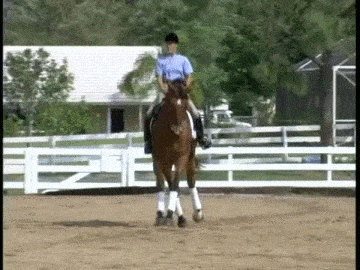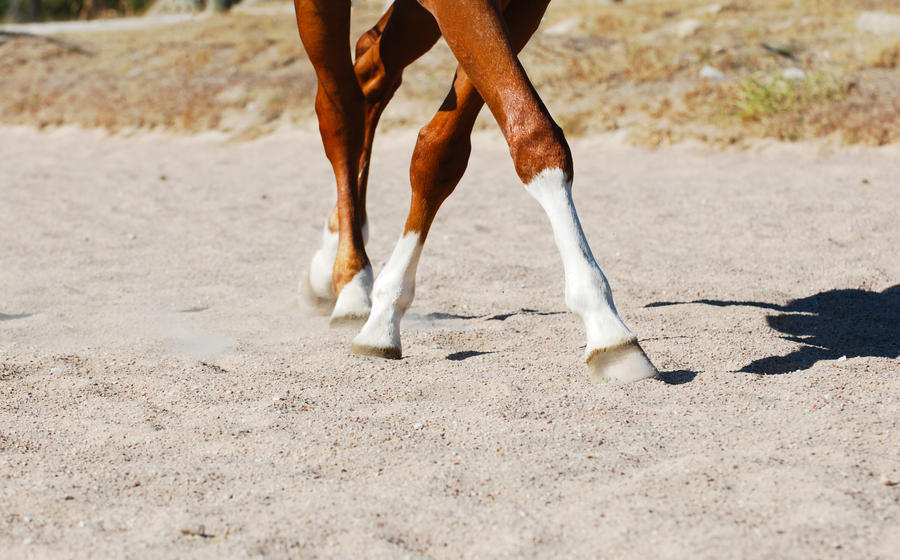Today's topic is leg-yielding - the applications, the aids, and the training of!
What's a leg yield? Only my most favorite of torturous exercises for my students due to it's versatility and overall handiness!
A leg yield is a diagonal movement wherein the horse moves forward and sideways - generally aiming for traveling at about a 45 degree angle. The horse is bent away from the direction of travel... but not too much.
I generally teach my riders by first practicing our turns on the forehand, then discussing how the reins can influence the horse to remain straight.
I have the student keep their reins short without acting backwards (my horses tend to quite willingly start to back up when the student clutches too much on the reins). I help them put their leg in the correct position (just slightly behind the girth) and encourage the student to use their hamstring to pull the leg into the horse's spine. Release with each step and pet the horse. If the reins lengthen while we're focused on the leg, the horse will generally move forward. We'll go both directions with our turns on the forehand before moving on.
We then move on to a spiral exercise, where the horse walks a very small circle and using the leg yielding aids the rider spirals the horse back to a large circle. And once I feel we've got that put together pretty well, we'll advance to leg yielding on straight lines.
The most difficult part for riders is to make sure that you use your outside rein to hold the shoulder straight without pulling back into your lap. I also warn against staring at their shoulders or head and instead turn to look along my path of travel. Look where you want to end up on the rail.
Leg yielding can get wonky because it's a single term for quite a few different movement. I fall prey to this myself, when I say such things as "leg yield through the corner." I do not want your hindquarters off the path of travel, instead I want the suppleness created from a prompt response to the leg.
I primarily deal with a nose-to-wall leg yield (wherein the shoulders travel along the rail but the hindquarters are toward the center of the arena) and a more direct leg yield, wherein the horse's body remains parallel to the wall.
Our dressage masters themselves have much to say on the matter of a leg yield.
Jane Savoie goes into wonderful detail in her books, but I'll keep it brief. She says that for a leg-yield over to the right, you sit squarely and balanced over the middle of your horse. You right leg is on the girth for forward movement. The left leg is behind the girth for sideways movement. Both legs are passive unless the horse needs to be sent either more forward or more sideways. In the case, the appropriate leg squeezes and releases. The left rein vibrates for flexion at the poll, and the right rein is steady and supporting to keep the neck straight.
 |
| Pg 152 of Dressage 101 |
Richard Watjen suggests training and perfecting the turn on the forehand first. He says, "At the halt the rider puts his horse to the bit, maintaining a light contact with both reins. The horse has to stand quietly and squarely on all four legs... The rider's inside leg (in the turn to the right, the right leg) behind the girth drives the hindquarters step by step round the forehand... During and after the turn the rider prevents a creeping back through the use of the driving aids of his own back and legs. A proper rhythm and even steps are essential. As soon as the movement is finished, the rider should proceed on a straight line."
Watjen warns against practicing the turn on the forehand too often, as "it puts the weight of the rider on the forehand, but it is indispensable in the preliminary stage of training."
General Anders Lindgren generally agrees with Watjen, suggesting that "in every corner of a 15 meter square, the rider performs a quarter turn on the forehand." As a reader, I love the structure of Lindgren's books... he writes: "observe that the rider keeps the horse straight in the whole neck except for a slight position at the poll, that the influence of the outside rein keeps the horse from collapsing in the base of his neck, that the rider carries his whip in his inside hand prepared to use it on the horse's flank, that the rider through the turn keeps the horse's jaw and poll supple. Thus the rider has the feeling of wringing tension and resistance out of the horse like wringing a wet wash sponge at the sink."
Richard Davison says "for leg yield, step into your inside stirrup without leaning over - keep your body weight central. Nudge the horse over with your inside leg and control the bend with your outside rein and outside leg."
 |
| Carl Hester's summary of leg yields. |
And how about our jumping masters? Surely they thinks leg yielding is of some importance?
Margaret Cabell-Self, (whom I consider to be one of my finest trainers, even though she died thirty years before I was born) clarifies why Racinet doesn't comment on the leg yield. "The exercise recommended by German trainers helps make the horse responsive to the unilateral leg aids and prepares him for more advanced training... This exercise is not designed to flex the horse's whole body as does the more difficult and advanced movement of the shoulder-in, [instead the leg yield makes] it possible to mobilize the haunches at will."
Anne Kursinski stresses how the relative straightness of the horse is important in order to actually create the movement. "Keeping his haunches and shoulders in line is an important part of the work. As with your earlier bending work, you'll probably need some experimenting to find the hand-to-leg ratio that keeps him straight and produces the smooth forward-and-sideways movement you're looking for." She also says, in reference to her photos: "His neck is straight because my arms and hands are quietly in a connection -- not pulling or crossing over the withers. Nor am I dropping a shoulder or hips or my eyes. I'm riding with feeling; I go with him, trying to do just enough to keep him straight and no more -- like balancing a broom in the palm of my hand."
Paul Cronin notes that "many horses have one side that they yield to more easily. When first teaching any new lateral movement, consider starting on the softer side in order to introduce it more easily. Then tactfully emphasize the stiffer side." Cronin's three patters for teaching leg-yielding are:
- Leg-yielding from the quarter line to the rail; i.e. right to left: The horse is looking right and yielding left from an inside right leg. Before the end of the ring or sooner, if a resistance or a loss of impulse occurs, straighten and go forward.
- Leg-yielding from the center line executed as above.
- Leg-yielding on a circle spiraling out to a larger circle.
Anna Jane White-Mullen says for a nose-to-wall leg yield left, you aids are a left indirect rein, left leg behind the girth, right leg at the girth.



This is a fantastic help to me, thank you. I'm not sure why I wasn't following your blog yet before, but I am now!
ReplyDeleteYou're so welcome! I tend to become obsessed with a topic and dig through my pile of books looking for exercises and advice, so I finally decided I should just compile the advice in a place I can go back and find it more easily!
Delete